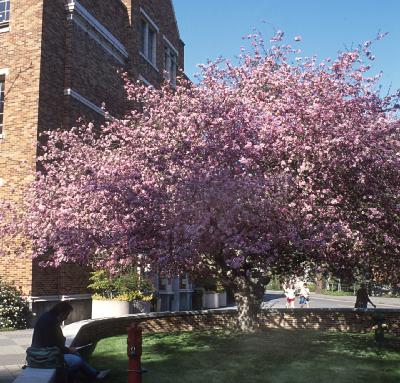January 8, 2004
Beloved tree now a hazard, faces removal
On a campus known for its majestic scenery and verdant grounds the “Pink Beauty” crab apple near the Department of Communication building has been a longtime favorite — maybe too long.
The tree, which sits near the bus stop between Communication and Stevens Way, is scheduled for removal on Jan. 24. And while admirers of the tree lament its forthcoming demise, the UW’s campus landscape architect says the removal is probably overdue.
“It’s a hazard,” said Bill Talley, who has been the driving force behind the overall landscape of the UW campus for most of the last 20 years.
Talley points to some of the branches that have literally no bark remaining, then he notes the excessive fungi growth near the tree’s roots, which leads him to a painful conclusion: “that tree is rotted beyond belief.”
Talley and others say it’s unsafe to keep the tree in the ground any longer. If it came down unexpectedly it could be hazardous in such a high traffic area.
“It should have been removed a long time ago,” he said. “It’s probably been around five years longer than it should have been, but that’s because everyone loves it so much.”
And for good reason. When in bloom, usually for about three weeks during the month of May, the tree is among the most spectacular sites on campus.
“The blooms are remarkable because they are so plentiful,” said Nora Strothman, the UW gardener who has cared for the tree for the last 12 years. “It’s an almost magenta pink, and there’s so many of them that you can’t see through the tree. It’s a solid mass. You come around the corner and see this huge pink statement that takes your breath away.”
At least that’s how it used to be. During the last several seasons the bright pink blossoms have been less plentiful and less colorful, leading Strothman to agree with Talley’s assessment. In fact, she says anyone who has watched the tree during the last several seasons has probably noticed the decline.
“This doesn’t come as a surprise to anyone, but people are so attached that it is a really sad event,” she said. “It breaks our heart. As gardeners we do everything we can to maintain trees. This is the saddest thing we have to do — remove something as beloved as this tree.”
According to the Brockman Memorial Tree Tour, www.washington.edu/home/treetour, the tree is the only known “Pink Beauty” in Seattle. This adds to the sense of urgency campus officials feel in preserving the tree. While tree No. 34 on the tour will come down, 25 scions are already in pots and will be planted on campus as they mature.
Another crab apple will be planted in place of the current one, which was received by the arboretum in 1948 then moved to campus during the 520-freeway project. A lifespan of 55 years or so, Talley says, is not uncommon for a crab apple.
“Crabs tend to get diseased,” he said. “So a 55-year lifespan is not bad. I know people can’t stand the thought of it, but the tree is really past its prime.”
Strothman is philosophical about the future. She hates to see the tree go, but knows that it’s just part of the natural cycle.
“When you’re a gardener, you do things for the present, but you also invest in the future,” she said. “So the tree we replace that crab with will, in our lifetime probably never mature to what we’ve enjoyed from this tree. But for many years we’ve enjoyed the gifts of someone else’s labor. Now it’s up to us to do something that future generations will enjoy.”



